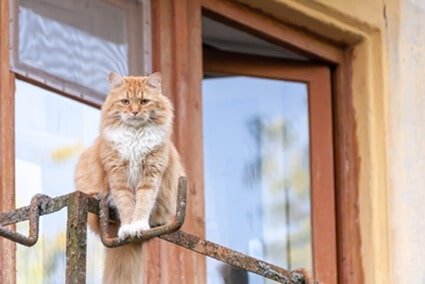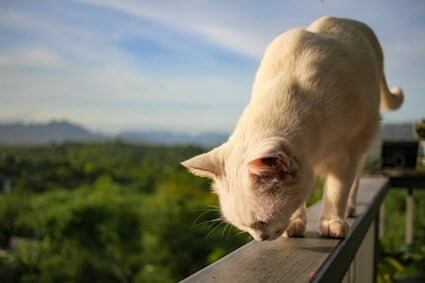Houses and high-rise apartments with balconies are unsafe for cats. As such inquisitive creatures, cats will naturally want to explore what’s going on outside. This could lead to an error of judgment. You’ll definitely need to restrict your cat’s access or safety-proof your balcony.
Cats have good survival instincts and are extremely unlikely to jump from balconies consciously. However, cats can easily have accidental falls. They may lose their balance while walking on a balcony, be blown off by strong winds, or chase birds and miss their landing.
A cat’s flexibility and sharp reflexes allow it to turn right-side-up as it falls so that it lands on the soft pads of its feet. Falls from greater heights cause cats to spread out in a flying-squirrel position to slow their fall. These abilities may allow some cats to survive multi-story falls, but they often sustain severe injuries, such as broken legs, punctured lungs, and head injuries.
Why Do Cats Like Balconies?
Feline instinct dictates that cats will often gravitate to balconies. Consider this an extension of your cat’s behavior inside the home. You will often find your cat hiding or sleeping atop a closet or refrigerator.
This is because cats enjoy elevated vantage points. At ground level, cats are vulnerable. They are surrounded by humans or other animals of vastly greater size. This makes it difficult for cats to protect themselves.
When located higher than a potential threat, cats can see all around them. They’ll see and hear danger coming and have time to react. Outdoors, threats are found everywhere. This makes a balcony an appealing location.
As any owner knows, what a cat enjoys is not always what is best for them. If you live in an apartment with a balcony, practice great care. Dangerous incidents, especially in warm weather, are commonplace.
Are Balconies Safe for Cats?
As the temperature increases outdoors, so does the incidence of “high-rise syndrome” in cats. A cat’s access to the balcony should be restricted for this reason.
“High-rise syndrome” is a term coined in the 1980s when cats were brought into a veterinary clinic in New York over a 5-month period due to falling off balconies and high-rises.
The cats had significant injuries, such as head and facial injuries, broken legs, and chest trauma. Despite a cat’s ability to land on its feet, it’s not uncommon for a cat to die after falling from a balcony.
Do not be fooled by its name. Although high-rise syndrome refers to Manhattan skyscrapers, any fall is dangerous. As we will discuss shortly, falling from the 4th floor could be more hazardous than a fall from the 14th story.
Always assume that a cat will fall from a balcony. “Fall” is the key term here. Your cat may not willfully leap from height from recreation, but this does not make an unwitting descent impossible.

Cats Don’t Jump from Balconies on Purpose
Cats are governed by their survival instincts. So, it’s unlikely that a cat will willfully jump from a balcony. We would go as far as to call this almost unheard of. Alas, this does not mean you can become complacent about balcony safety.
In the wild, cats go to great lengths to remain safe. Therefore, a cat will never deliberately jump from a high place. They understand this could lead to injuries or death. This why cats climb trees in a yard then find themselves trapped.
So, why is there such a high number of high-rise incidents during the summer months? Cats have amazing survival instincts, but they also tend to focus on one thing that piques their interest. This can result in a fall. Common explanations for cats to fall from high-rise balconies include:
- Chasing prey, such as a bird or squirrel, and lunging from a balcony
- Tracking prey and growing distracted or startled by external noise
- Fleeing from something that frightened the cat
- Misjudging a jump to another platform of equal height
- Following a unique scent or noise and losing concentration
- Unspayed or unneutered cat responding to a mating cry
This is likelier to happen during warm weather than in the heart of winter. Cats love the sun. Many pets instinctively seek out warmth for basking, while prey will also be plentiful during the summer months.
Cat’s Don’t Always Land on Their Feet
Cats have exceptional balance. Most cats are well-muscled, agile, and have a remarkable perception of depth. They also have the ability to navigate narrow ledges and branches because of their single-tracking foot placement.
If a cat loses balance, it responds promptly. Cats have flexible spines and phenomenal reflexes, allowing them to turn right-side-up as they fall. Landing on the soft pads of their feet softens their landing and lowers the risk of injury.
This is only true if a cat falls from a height greater than 1-2 feet. Short distances don’t provide enough time for a cat to adjust its body. This creates a paradox in which shorter tumbles can be more dangerous than long falls.
A cat falling from a first or second story can correct itself, but it may not be perfectly positioned to land safely. This means that cats don’t always land squarely and safely on their feet. It’s a dangerous myth.
How Does a Falling Cat Land?
In many cases, they land with their feet splayed apart slightly. A cat falling from a balcony may survive. The cat is likely to experience serious pelvis and head injuries, though.
Falls from greater heights cause cats to spread into a “flying squirrel” position. This slows descent and allows them to survive their initial fall. This is known as terminal velocity. The pull of gravity means that the speed of falling has peaked.
Just remember, survival is only half the concern. Cats may have high survival rates from falls, but they typically sustain multiple traumatic injuries upon landing. These include:
- Broken legs
- Fractured jaws and teeth
- Punctured lungs
- Ruptured organs
- Head injuries
- Shattered pelvises
According to the Journal of Feline Medicine and Surgery, of the 119 cats that had fallen from high rises within a 4-year period, about 97% survived but sustained severe injuries. 46% of these cats had fractured limbs, and 34% had thoracic trauma. Falls were far more frequent during the warmer months, confirming our previous hypothesis.
Impact Injuries in Cats
The most serious impact injury that cats can experience is to the head. A concussion can have long-term consequences that are not immediately obvious. Just because a cat is conscious, it doesn’t mean it is unharmed.
Check for any bleeding from the nose or head. Even if your cat is not seemingly in imminent danger, monitor it closely. Upon the onset of any of these symptoms, seek help at once:
- Lack of coordination (walking in circles, for example)
- Trouble walking
- Growing confused, such as forgetting where to find food or water
- Uneven pupil size
- Tilting the head to one side
Brain or head injuries are not the only concern. Cats may try to walk off a broken leg or even an injured tail. If the bones do not knit together appropriately, permanent skeletal misalignment becomes possible.
Naturally, internal injuries to key organs are equally dangerous, especially in older cats. As felines age, their organs cease working to capacity anyway. Physical trauma can speed up degradation, leading to serious illness.
Be mindful of any change in your cat’s behavior. This could include a reluctance to eat or drink, hiding more often than usual, uncharacteristic aggression, or a loss of interest in exercise or play.
These actions point to a possible injury, whether internal or external. The longer this problem is left untreated, the worse it will grow. While cats are capable of healing their own wounds through purring, there are limits to this ability.
Cats Don’t Always Survive Their Falls
We just referred to the high survival rate of high-rise syndrome. As discussed, cats that fall from high places have a 90% survival rate – if they’re provided with immediate and appropriate medical attention.
In the Journal of American Veterinary Medical Association, 132 cats were studied after falling from an average of 5.5 stories and a maximum of 32 stories. Cats that fell from greater heights had enough time to reach terminal velocity and showed a survival rate of 90%.
2/3 of the 132 cats needed medical treatment as a result of their impact with the ground. Also, 37% of the cats with thoracic trauma and shock would not have survived if they weren’t given life-sustaining treatment.
If your cat falls from height, it will likely seem to dust itself off and walk away. Do not be fooled by this behavior. The cat may have experienced serious, potentially life-changing, injuries. These may yet have serious repercussions. There is every chance your cat needs veterinary attention after a fall, regardless of appearances. It may succumb to injuries after several hours or days.
Consider a fall from a height to be every bit as dangerous as a road traffic accident. Both of these concerns are responsible for a significant level of feline mortality.
How to Stop Cats from Falling Off Balconies
It’s only natural that you may want to leave doors to a balcony open during the summer months. Ask yourself if the fresh air provided is a fair trade when considering the risks to feline safety, though.
Cats can be strong-willed and are driven by instinct. As a result, you need to be careful about providing an opportunity to fall from a balcony. Cats are also skilled escape artists, so a screened-in enclosure may be insufficient.
Screens that are high enough to prevent cats from climbing onto them may work. You will need to move any furniture away from balcony edges. If cats can use something as a springboard, they will.
If you want to allow your cat to get some air, keep it on a leash while outside. This must be a harness, with the least attached to the back or chest. A collar is a choking hazard if the cat leaps without warning.
Alternatively, you could keep your cat off a balcony. There are several ways to achieve this, and all of them require training, patience, and vigilance. When a cat gets an idea in its head, it will seek every opportunity to make it a reality.

Keepings Cats Away from Balconies
There are three main techniques for keeping cats away from balconies. These are best utilized in tandem:
- Making the balcony unappealing
- Providing an alternative outdoor space
- Managing feline hunting instinct
You can make a balcony unwelcoming to cats can achieve through scent and texture. Do not provide any hiding places, such as plants, and apply unappealing scents. Pepper and citrus fruit are popular choices.
You can also amend the texture of the balcony ground. Cats loathe sticky sensations, for example. This will only work if you also do not use your balcony.
As discussed, cats like to spend time outdoors when the weather is warm. With this in mind, consider allowing your cat into the yard. If this is not an option because you live in an apartment, leash-train the cat and take it for a walk.
The less active and agitated your cat is, the less likely it is to seek outdoor prey. Play with your cat at least twice a day. This will satisfy feline hunting instincts. As a result, your cat is less likely to hunt wildlife, most notably birds.
If your cat falls from a balcony, always get it checked over by a vet. High-rise syndrome only has a high survival rate if the casualty is given immediate medical care. Do not assume that your cat is fine, as the damage may be internal.

